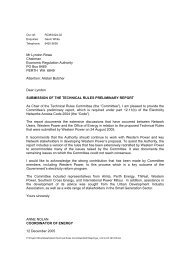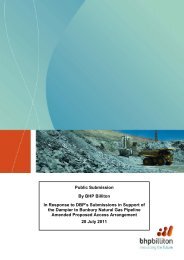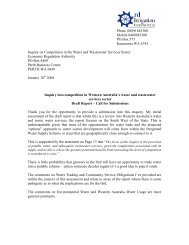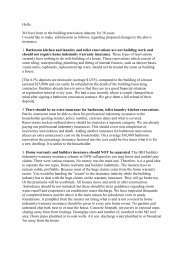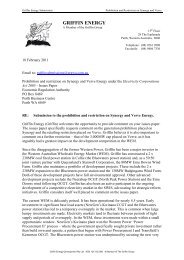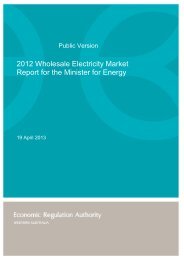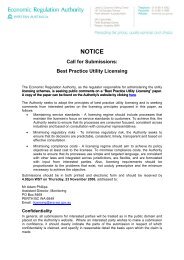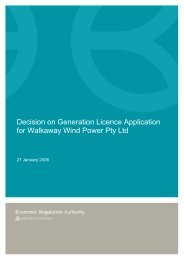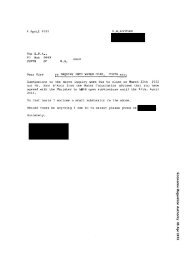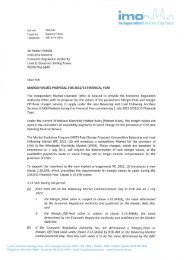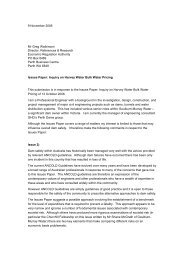Western Power Network Pricing - ERA Economic Regulation ...
Western Power Network Pricing - ERA Economic Regulation ...
Western Power Network Pricing - ERA Economic Regulation ...
Create successful ePaper yourself
Turn your PDF publications into a flip-book with our unique Google optimized e-Paper software.
Source: Averages drawn from GBA, p. 115 reproduced at <strong>ERA</strong> Draft Decision, p. 58, table 11. <strong>Western</strong> <strong>Power</strong>’s performance<br />
improved by 2 per cent each year from the performance reported in table 11.<br />
Table 2: Modelling a three percent cumulative opex efficiency improvement ($ real, 2012)<br />
<strong>Western</strong> <strong>Power</strong> performance Opex/Km line Opex/Customer Opex/RAB (%)<br />
for year ending:<br />
2012-13 4372 420 7.0%<br />
2013-14 4241 407 6.8%<br />
2014-15 4113 395 6.6%<br />
2015-16 3990 383 6.4%<br />
2016-17 3870 372 6.2%<br />
Average current performance<br />
in the comparator group<br />
3994 374 5.7%<br />
Source: Averages drawn from GBA p. 115, reproduced at <strong>ERA</strong> Draft Decision, p. 58, table 11. <strong>Western</strong> <strong>Power</strong>’s performance<br />
improved by 3 per cent each year from the performance reported in table 11.<br />
It is clear from table 1 that a two per cent improvement each year will leave <strong>Western</strong> <strong>Power</strong> at the<br />
end of the AA3 period in 2016-17 above the average of the comparator group on all three<br />
benchmarks. For example on the Opex/Km line benchmark, <strong>Western</strong> <strong>Power</strong> will in 2016-17 be at<br />
$4074/km line compared to the current average performance of $3994/km line length.<br />
Table 2 shows that a three per cent efficiency dividend will drive <strong>Western</strong> <strong>Power</strong> to just under the<br />
current average performance for Opex/Km line and Opex/Customer, and still above the average for<br />
Opex/RAB. This suggests that a three per cent efficiency dividend is more appropriate. Even with a<br />
3 per cent annual efficiency improvement, <strong>Western</strong> <strong>Power</strong> would only be approaching the historical<br />
level of efficiency of the comparator group. This historical level of efficiency is in turn drawn from<br />
data as old as 2008, as can be seen from the sources identified in the GBA report. 9 Even if <strong>Western</strong><br />
<strong>Power</strong> catches up to this historical average, it is likely still to be lagging best practice by a margin<br />
given improvements by the comparator group up to the end of the AA3 period in mid-2017.<br />
The Council’s view is that a three per cent efficiency dividend will move <strong>Western</strong> <strong>Power</strong>’s<br />
benchmarked performance closer to the average of the interstate comparisons. A two percent<br />
efficiency dividend would not do enough to drive <strong>Western</strong> <strong>Power</strong> towards the average performance<br />
level, especially as that average is likely to have improved over the period of the AA3 access<br />
arrangement.<br />
Recommendation 2: Require a 3 per cent opex efficiency dividend for <strong>Western</strong> <strong>Power</strong>.<br />
9 GBA, p. 115, sources identified at foot of table 10.2.<br />
13




